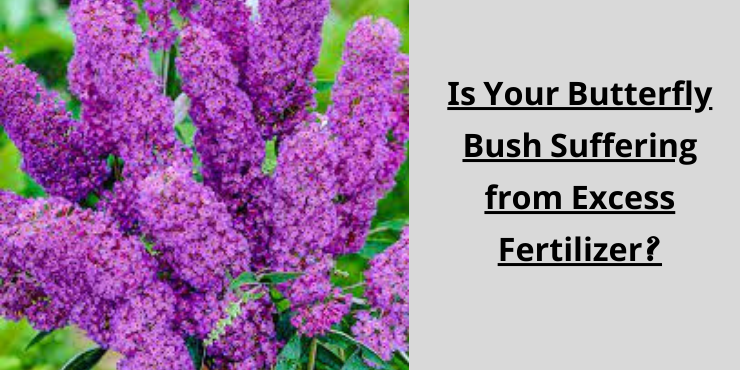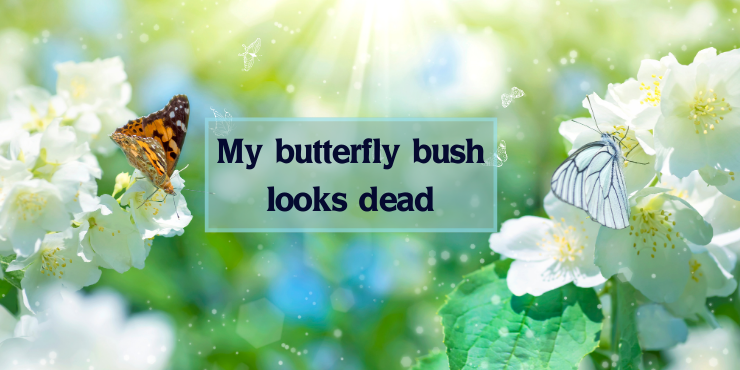My Butterfly Bush Looks Dead
It’s concerning to see a Butterfly Bush in a state of decline since these shrubs are known for their robustness. However, several common issues can affect them, such as overwatering, poor drainage, drought-related stress, excessive fertilizer application, pests, and diseases. If you notice any symptoms, it’s essential to identify the underlying problem and take steps to resolve it promptly. Butterfly Bushes can thrive in less-than-ideal conditions and often recover quickly once you address the issue. To help you pinpoint the problem and preserve the vitality of your Butterfly Bush, here’s a guide on how to recognize and address the issues that may be endangering it.
Survival is Not Always at Stake for Issues
Butterfly bushes are a common sight in many gardens, and those who have been nurturing them for a long time may be familiar with this scenario. As the temperature rises and trees and shrubs around them are adorned with fresh green leaves, their buddleia appear as nothing more than a collection of lifeless, gray-brown stems. These stems may seem brittle and devoid of vitality, breaking off easily with a gentle grip.
If you are wondering whether your butterfly bush is on the brink of demise or has already perished, there’s a strong probability it’s in excellent health. Buddleia davidi, the common butterfly bush, typically takes its time to spring back to life during the early spring season.
It’s not uncommon for them to maintain their dead-like appearance until early June, especially following particularly cold winters or delayed spring arrivals. Moreover, it’s quite common for these shrubs to experience some degree of winter dieback, sometimes even substantial dieback. Butterfly bushes are known for their resilience in USDA Zones 5-9. In Zones 5 and 6, it’s not unheard of for everything above the soil to wither away. As long as the roots have endured, you can expect to witness some green shoots emerging from the ground before too long.
Safeguarding Your Buddleia Against the Cold of Winter

Could Excessive Watering Be Harming my Butterfly bush looks dead?
Indicators: Extensive yellowing of leaves, particularly lower on the plant; flaccid, tender foliage; floppy, sagging stems; minimal to no growth; leaves shedding from the plant.
If my Butterfly Bush is in the throes of decline, the leading culprit is most likely excessive watering. These resilient plants can endure various conditions, but excessive moisture in stagnant soil can be a tipping point.
When the soil is saturated, the roots struggle to access oxygen efficiently. Simultaneously, specific strains of fungi and bacteria that thrive in anaerobic environments can proliferate and assail your plant. The dual impact of suffocation and infection can inflict substantial harm.
Watch out for the aforementioned red flags: an overwatered Butterfly Bush typically displays wilting and drooping, accompanied by the softening and yellowing, or even browning, of its leaves. When these symptoms manifest, employ a moisture meter to examine the soil. If it remains damp and you haven’t watered in the past few days, it strongly suggests overwatering.
This predicament frequently arises when my Butterfly Bush is ensconced in excessively compact, water-retentive soil, frequently containing a high clay content. Buddleias can thrive in diverse settings, yet they generally flourish in coarse, well-draining soil. Alternatively, the issue may lie in the shrub’s placement in your yard’s low-lying area, prone to water pooling. Lastly, it is possible that. watering my Butterfly Bush too frequently.
Rescuing an Overwatered Butterfly Bush
In case you’ve unintentionally overwatered my Butterfly Bush, the initial step entails allowing the soil to thoroughly dry out. Refrain from providing any water for approximately a week or until the top two inches of soil have become completely dry. If you observe an improvement in its condition, there’s a chance it will recover.
However, if the plant continues to deteriorate, or if the soil remains persistently saturated, it might suggest an underlying drainage problem. This issue can often be addressed by either relocating my Butterfly Bush to a different spot or by replanting it with the root mass positioned higher in the soil.
During the transplantation process, take the opportunity to inspect the roots. If you come across any roots that appear slimy, mushy, or discolored (gray or brown), or any soft, decaying stems, remove them entirely using a pair of shears. Be sure to disinfect the shears with rubbing alcohol between each snip.
It’s also worth noting that dehydration can pose a potential issue.
Inadequate Hydration Poses a Challenge for my butterfly bush looks dead as Well
Indicators: Dehydrated, withered leaves; sagging stems; sluggish growth; leaf margins browning.
Insufficient watering seldom ranks high among typical issues affecting Butterfly Bushes. However, it can occasionally occur, as every plant possesses a threshold for dryness. Buddleias generally exhibit a strong drought tolerance once they have taken root, but during their inaugural year in the soil, regular watering is essential.
Even after a Buddleia has firmly established itself in your garden, it’s advisable to provide a thorough watering session whenever temperatures soar above 85℉, and there has been less than an inch of rainfall in the preceding week.
It’s essential to bear in mind that when your plant is situated in an exceptionally sunny location, it will demand more frequent watering. Butterfly Bushes thrive in direct sunlight, but their thirst increases under such conditions. An underhydrated Buddleia in an intensely sunny spot may exhibit scorch marks on the leaves, primarily affecting the portions of the plant facing south and west. These irregular patches consist of dry, pallid tissue.
Especially during the hottest and sunniest periods of the year, it’s a prudent practice to regularly inspect the soil. If it has remained dry for approximately a week, consider providing my Butterfly Bush with a generous, replenishing drink of water.
Rescuing a Dehydrated Buddleia
Reviving an underhydrated Butterfly Bush typically involves simply providing it with a drink. Although the damaged foliage won’t recover, the plant should cease wilting within a day or so, and it will soon commence producing fresh, robust growth.
However, it’s crucial to avoid mistaking an overwatered Buddleia for one suffering from dehydration. The initial symptoms can appear quite similar, so it’s advisable to examine the soil’s moisture level before proceeding with hydration.
If your plant is exposed to intense sunlight during scorching conditions, consider employing a bit of light shade cloth as a potential aid. Nevertheless, exercise caution not to overdo it with shade, as excessive shade can impede flowering. Providing a few hours of shelter during the hottest part of the afternoon is typically sufficient.
Is My Butterfly Bush Suffering from Excess Fertilizer?

Indicators: Brittle leaves with brown or blackened tips; wilting; patches of bleached or rust-colored discoloration on the foliage.
Another potential cause of dehydration in a Butterfly Bush is excessive fertilizer application. B. Davidii does not fall under the category of what some gardeners refer to as a “heavy feeder.” It requires minimal fertilization. Unless the soil exhibits a specific nutrient deficiency, applying a two to three-inch layer of compost each spring should suffice.
If you find yourself applying an abundance of synthetic fertilizer, particularly fast-acting liquid or powdered formulas, my Butterfly Bush could encounter difficulties. These types of fertilizers are typically composed of mineral salts designed for easy absorption by plant roots.
However, it’s essential to acknowledge that your Buddleia can only assimilate a limited amount of nutrients, and any excess will accumulate in the soil. When these mineral salts accumulate to elevated levels, they can impede proper root function, resulting in a condition known as fertilizer burn, characterized by a scorched and dehydrated appearance in the plant.
Underlying all of these challenges are exacerbated by insufficient watering and inadequate drainage. A sufficient water supply within the soil aids in pushing excess fertilizer deeper into the ground, effectively distancing it from the plant’s roots and promoting the overall health of my Butterfly Bush.
Rescuing a Butterfly Bush From Fertilizer Burn
If your shrub is enduring the consequences of excessive fertilizer application, a generous dousing of water can often be a remedy. Administer a thorough soak to the butterfly bush that looks dead, using a quantity of water that’s four to five times greater than your typical amount. This can assist in flushing out the surplus minerals from the soil.
Although the existing damage won’t disappear, your Buddleia should gradually revert to its customary, healthy growth patterns. To forestall this issue in the future, it’s generally advisable to curtail your fertilizer usage. For more comprehensive recommendations, you can explore the detailed suggestions provided here.
Nutritional Deficiency Challenges in a Butterfly Bush
Indicators: Lethargic growth; diminished flowering; undersized, withered, or distorted leaves; extensive discoloration affecting the newer foliage.
As previously mentioned, it’s improbable that your Buddleia requires additional nutrients. However, “unlikely” doesn’t equate to “impossible.” Certain garden soils might be deficient in essential minerals that your plant cannot thrive without, leading to the emergence of an ailing Butterfly Bush that appears to be in decline.
The most reliable means of verification involves conducting a soil test. The resulting report should elucidate precisely which vital elements my butterfly bush looks dead is lacking.
Rescuing an Under-Fertilized Butterfly Bush
The remedy in this situation is straightforward: enhance your soil to compensate for the nutrient deficiency. It’s typically more effective to address the specific element that’s deficient rather than applying a generic, all-purpose fertilizer in abundance. Numerous soil testing facilities are capable of providing precise recommendations regarding the appropriate amendments to incorporate into your garden to rectify the issue.
Fertilization is generally most effective during the spring, precisely when my butterfly bush looks dead initiates its growth phase. Additionally, bear in mind that the potential for fertilizer burn underscores the importance of ensuring your plant receives an ample supply of water.
Is Verticillium Wilt Afflicting Your Buddleia?
Indicators: Extensive clusters of leaves curling inward and transitioning to a yellow or brown hue.
Verticillium is a highly pernicious and aggressive fungus that can wreak havoc on various types of trees and shrubs. It propagates through both the soil and the tissues of afflicted plants, obstructing the vascular system of a Butterfly Bush. This impedes the circulation of water and nutrients to the leaves.
The outcome is a widespread decline in leaves and branches, typically manifesting in irregular patterns. At times, it may affect only a portion of the shrub, leaving the other half seemingly unaffected. Alternatively, it can target solely the outermost branches. Often, the distribution appears entirely random.
If you suspect my butterfly bush looks dead and has succumbed to verticillium wilt, you can perform a diagnostic test by gently scraping off a section of bark using your nail or a knife. (Remember to disinfect the tool afterward to prevent the spread of infection to other plants!) The presence of the disease is indicated by the presence of black streaks within the wood’s grain.
Rescuing a Butterfly Bush with Verticillium Wilt
Regrettably, there are limited remedies available for this disease, making it one of the more formidable challenges faced by Butterfly Bushes. Reliable fungicides for treatment are scarce, and this ailment can be particularly stubborn. However, the presence of verticillium wilt doesn’t necessarily condemn your Buddleia to a lost cause. Occasionally, the plant can mount its defense against the disease, although there isn’t much you can do to expedite the process.
One helpful measure is pruning away any ailing branches, but it’s vital to disinfect your pruning shears with rubbing alcohol before each cut. Dispose of the removed branches by burning or placing them in the trash rather than incorporating them into a compost pile or leaving them in wooded areas.
Ensuring proper hydration during the summer months is crucial since verticillium wilt can heighten the risk of dehydration. Additionally, applying mulch can be beneficial. In the spring, it’s advisable to prune your plant as close to the ground as possible, promoting vigorous regrowth and increasing the likelihood of removing all infected limbs.
With some luck, your Buddleia may overcome the infection. However, if it continues to wither and decline, you’ll need to uproot and dispose of it. It’s essential not to attempt to cultivate other plants in the same location, as the fungus can persist in the soil for an extended period.
Insect Challenges and the Butterfly Bush
Indicators: Impeded growth; leaves resembling they’re coated in rust or dust; webbing apparent on foliage; clusters of unusual bumps on branches; jagged perforations in leaves; adhesive residue; dark, sooty discoloration.
Butterfly Bushes generally exhibit resilience against pest infestations. Nonetheless, certain insects and mites can become problematic for these plants, particularly during periods of stress. Here are some of the more prevalent ones:
- Spider mites: These minuscule sap-sucking pests are nearly imperceptible to the naked eye. They thrive in arid conditions and often target plants experiencing drought stress. Spider mites tend to leave conspicuous patches of small scars on leaves and construct clumps of unsightly webbing.
- Aphids: These troublesome insects cluster in tiny groups near the ends of branches, usually adhering to the newest growth. They come in a surprising array of colors, including green, red, yellow, brown, and black. Aphids leave behind sticky deposits known as honeydew, which can attract ants or give rise to sooty mold.
- Japanese beetles: These voracious, swarming pests can quickly strip leaves, rendering them limp and skeleton-like. Adult Japanese beetles possess metallic-looking bodies with green heads and torsos, while their backs are covered in copper-colored wingcases. They often exhibit fuzzy white patches on their sides and abdomens.
While these creatures are unlikely to cause the demise of my Butterfly Bush, they have the potential to inflict substantial damage that hinders growth and blooming. If you identify any of these pests, prompt action to eliminate them is advisable.
Rescuing a Butterfly Bush From Pests
Initiating the pest control process involves rinsing my Butterfly Bush with a forceful stream of water, which effectively dislodges many insects, reducing the burden on your buddleia. Additionally, it creates less favorable conditions for spider mites since they thrive in dry environments.
Japanese Beetles can often be manually removed as well. The key is to rise early before sunrise and catch them while they’re resting on the leaves. Placing them in a container of soapy water will effectively eliminate them. To target their larvae, consider introducing predatory nematodes into the soil.
Applying insecticidal soap or neem oil to the foliage can also prove beneficial. These relatively gentle pesticides can exterminate invading insects without harming the pollinators that visit my butterfly bush to look dead. However, both treatments can heighten the plant’s susceptibility to sunburn, so it’s advisable to apply them in the evening and potentially introduce some shade cloth for a few days.
It might be necessary to repeat this treatment multiple times to completely eradicate the infestation. Ensure you space out the applications of pesticides by several days to avoid subjecting my butterfly bush look dead to excessive stress.
Conclusion:
Certain challenges faced by butterfly bush look dead pose a significant risk to the plant’s survival, notably overwatering and verticillium wilt. However, the majority of other issues are more inclined to cause cosmetic harm and hinder growth, though they can escalate if left unaddressed. By accurately identifying these problems and taking proactive measures, you can expedite your Buddleia’s recovery. With a touch of fortune, it should regain its health and vitality in no time!


